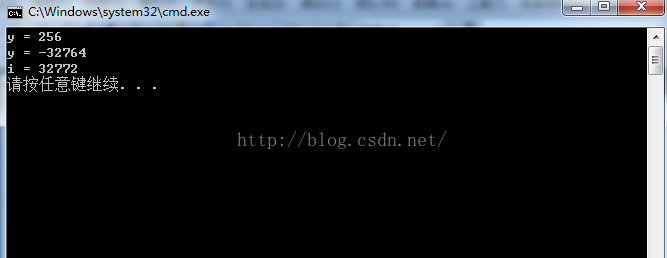C#學習日記16----隱式轉換特定用例
- 黄舟原創
- 2017-01-21 15:02:091837瀏覽
經過前面的學習C#中基本的資料類型就介紹的差不多了,下面就學習下類型之間的互相轉換.C# 中類型轉換可以分為2類: 隱式轉換和顯式轉換.
隱式轉換:
隱式轉換是系統預設的轉換,且不需要被申明轉換。在隱式轉換過程中,編譯器無需對轉換進行檢查就能夠安全的執行轉換,例如從int類型轉到long類型,就是隱式轉換。隱式轉換一般不會失敗,轉換過程中也不會遺失資訊.
例如:int i = 100;
轉換並非對任兩種類型都成立,例如,我們將上面的long型隱式轉換為int型別就不會成功:
long a = 100; 編譯器會報錯
因此隱式轉換有以下的規則:
隱式數值轉換
隱式枚舉轉換
隱式數值轉換包括以下幾種:- 從sbyte 類型到short、int、long、float、double、decimal類型;
- 從byte 類型到short、ushort、int、uint、long、ulong、f double、decimal類型;
- 從short 類型到int、long、flaot、double、decimal類型;
- 從ushort 類型到int、uint、long、ulong、flaot、double、demal
- 從int 類型到 long、flaot、double、decimal類型;
- 從uint 類型到 long、ulong、flaot、double、decimal類型;
- 從ulong 類型到 float、double、decimal類型;
從ulong 類型到 float、double、decimal型;
從char 型別到ushort、int、uint、long、ulong、flaot、double、decimal;
- 寫了這麼多總結下吧,概括的說就是從低精度類型到高精度類型轉換(因為不丟失精度與數據信息),而從高精度類型到低精度不能隱式轉換(可能會丟失部分訊息,不安全)。有關類型的精確度與範圍請參考 C#學習日記04 。這裡要提醒的是 不存在其他類型到Char類型的隱式轉換。
- 隱式數值轉換實例:
using System; using System.Collections.Generic; using System.Linq; using System.Text; namespace Test { class Program { static void Main(string[] args) { byte x = 255; //byte 表示的范围0~255 short y = x; //将从byte到short隐式转换 y++; Console.WriteLine("y = {0}",y); y = 32767; //shot的范围 -32768~32767 int i = y + 5; //从 short 到 int 隐式转换扩大范围 结果是准确的 y+=5; //超出范围了结果会不准确 Console.WriteLine("y = {0}",y); //y超出范围数据会丢失部分 Console.WriteLine("i = {0}",i); } } }結果: - 從這個例子可以看出,及時的採用類型轉換還是很重要噠。
-
隱式枚舉轉換允許將十進制0,轉換為任何枚舉類型,注意的是,它只能轉換0,對其他整數不存在這種隱式轉換,看下面的範例:
using System; using System.Collections.Generic; using System.Linq; using System.Text; namespace Test { class Program { enum weekday //定义一个枚举类型 { Sunday, Monday, Tuesday, Wednesday, Thursday, Friday, Saturday }; static void Main(string[] args) { weekday day; day = 0; //隐式将0转换为枚举类型(只能是0) Console.WriteLine(day); } } } 輸出結果是:
Sunday
上面程式碼中如果我們把day = 0 該為day = 1 編譯器就會給出錯誤。
隱式引用轉換:
從任何引用類型到物件類型的轉換;
(Person p = new Person())
s是t的派生類別;
using System;
using System.Collections.Generic;
using System.Linq;
using System.Text;
namespace Test
{
class person //定义了一个基类(父类) person
{
}
class person1 : person // person1 派生于基类person,person1就叫person的一个子类,
{
}
class Program
{
static void Main(string[] args)
{
person1 per = new person1(); //将子类person1实例化一个对象per
person Per = per; //将子类隐式转换为父类
}
}
}從類別類型s到介面類型t的轉換,其中類別s實作了介面t;(有關介面(interface)的內容後面會寫到,用它只聲明方法不定義方法)
using System;
using System.Collections.Generic;
using System.Linq;
using System.Text;
namespace Test
{
public interface Infa //定义了一个接口
{
void Output();
}
class person : Infa //定义一个person类继承于接口并实现方法
{
public void Output()
{
Console.WriteLine("Welcome");
}
}
class Program
{
static void Main(string[] args)
{
person per = new person(); //实例化
Infa fa = per; //从person到interface(接口)隐式转换
}
}
}從介面類型s到介面類型t的轉換,其中t是s的父介面;
using System;
using System.Collections.Generic;
using System.Linq;
using System.Text;
namespace Test
{
public interface Infa //定义了一个接口
{
void Output(); //接口只声明方法,具体实现由它的派生类写代码决定
}
public interface infa1 : Infa //定义一个infa1接口继承于Infa接口
{
void input();
}
class person1 : infa1 //由infa1派生一个person1类,因为接口不能直接实例化
{
}
class Program
{
static void Main(string[] args)
{
person1 per = new person1 { }; //接口不能直接实例化,需要实例化一个派生于infa1接口person1类
Infa fa = per; //实现子接口到父借口隐式转换
}
}
}- 引用型別數組s到引用型數組t轉換,其中s是t的派生類,並且數組維數得相同;
using System; using System.Collections.Generic; using System.Linq; using System.Text; namespace Test { class Person //定义一个基类 Person { } class person1 : Person //由基类派生一个子类person1 { } class Program { static void Main(string[] args) { person1[] per = new person1[5]; //实例化一个person1 Person[] Per = per; //实现隐式转换 } } }在這裡要提醒的是,引用型別數組如果是值型別數組以下程式碼就會報錯:
class Program { static void Main(string[] args) { int[] n_int = new int[10]; double[] n_doubel = new double[10]; n_doubel = n_int; //这里报错啦 } }從數組型別到System.Array的轉換;(Array是所有數組的基類參考上一篇^_^)
using System; using System.Collections.Generic; using System.Linq; using System.Text; namespace Test { class Program { static void Main(string[] args) { int[] n_int = new int[10]; //实例化一个int类型的数组 n_int Array arr = n_int; // Array表示的就是数组 所以不能Array[] arr } }從任何代表型別到System.Delegate的轉換;(後面會寫到delegate)using System; using System.Collections.Generic; using System.Linq; using System.Text; namespace Test { class Program { public static int output(int s) //定义一个方法 { Console.WriteLine("welcome,{0}",s); return 1; } public delegate int mydel(int s); //声明一个委托(以后我会说到委托) static void Main(string[] args) { mydel my = new mydel(output); //将 output方法委托给my Delegate MYDEL = my; //向 MYDEL 隐式转换 } } }以上就是 C#学习日记16----隐式转换具体用例的内容,更多相关内容请关注PHP中文网(www.php.cn)!

